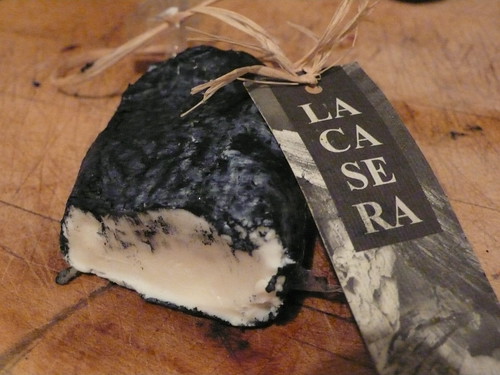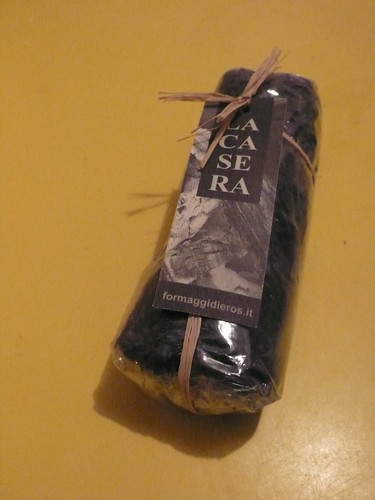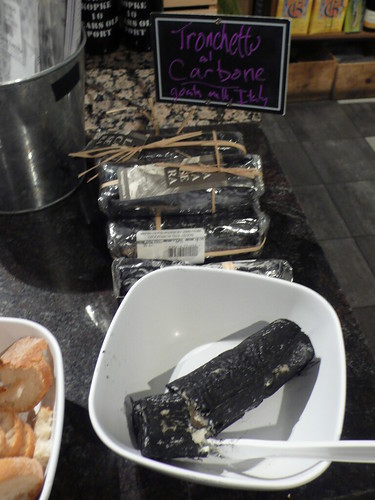
My introduction to vegetable ash came back in 2005, in the form of a very ripe slice of
Morbier. For this I thank my friend Sean, a Francophile whose constant hankerings for Morbier resulted in him often stocking this cheese in our fridge. It is a wonderful, rubbery French cheese that features a thin, black streak of ash running through its center. Traditionally that ash (which, in the 19th century, was legitimate, REAL charcoal) served to bisect two separate milkings—morning and afternoon—of the cow.
Morbier is no longer produced this way, sadly, except by
a family in Jura (this article is from 1985-- I can't find any more recent info on them online!). By the same token, the marriage of ash and cheese has completely evolved. Ash, once used by cheesemakers mainly for preservation purposes (as in the case of Morbier’s first layer that needed to keep overnight underneath a coating of ash), now functions as an aesthetic nod to tradition, though it is still utilized as a way to keep cheese from ripening on occasion.
In the case of Tronchetto di Capra al Carbone, a cheese I recently picked up while at Boston's
South End Formaggio, I also discovered the potency of ash as a flavor in its own right. Produced by
La Casera in Italy, this ash-laden goat cheese sells for a hefty $18 per log.

As a sucker for both packaging and originality, I convinced my brother to buy this one-of-a-kind must-have cheese as my stocking stuffer this past Christmas. He obliged, mostly to prevent me from sampling it twelve times in front of the other customers.

Tronchetto is made using a coagulation process that involves lactic acid and thus results in a soft, smooth texture that is slightly firmer than cream cheese. Aged for thirty days, Tronchetto is rolled in charcoal dust, an ingredient that I would argue is its
pièce de résistance. La Casera, a cheesemaker known to wrap cheeses in everything from cabbage to flowers in order to enhance flavor, understands how the addition of ash not only changes the textural composition of the cheese with its carbon granules, but it also impacts what you taste.
I’m not going to lie—there is an alkaline effect, and it’s difficult to appreciate this as anything extraordinary when first encountered. It tastes like carbon, plain and simple. But the more I’ve eaten this cheese (I did have an entire log of it, after all), the more complex it becomes. The cheese itself, straddling the line between sharp and mild, compliments the ash because it is not totally subsumed by the charcoal aftertaste. You taste the coal particles, you savour the cream and tang of the goat's milk. A perfect union.
Tronchetto may be the first instance where the inclusion of vegetable ash amounted to a transformative cheese-eating experience. And apparently I’m not the only one to identify the
power of ash as a comestible of late. Maybe the Icelandic were onto something last year.
 My introduction to vegetable ash came back in 2005, in the form of a very ripe slice of Morbier. For this I thank my friend Sean, a Francophile whose constant hankerings for Morbier resulted in him often stocking this cheese in our fridge. It is a wonderful, rubbery French cheese that features a thin, black streak of ash running through its center. Traditionally that ash (which, in the 19th century, was legitimate, REAL charcoal) served to bisect two separate milkings—morning and afternoon—of the cow.
Morbier is no longer produced this way, sadly, except by a family in Jura (this article is from 1985-- I can't find any more recent info on them online!). By the same token, the marriage of ash and cheese has completely evolved. Ash, once used by cheesemakers mainly for preservation purposes (as in the case of Morbier’s first layer that needed to keep overnight underneath a coating of ash), now functions as an aesthetic nod to tradition, though it is still utilized as a way to keep cheese from ripening on occasion.
In the case of Tronchetto di Capra al Carbone, a cheese I recently picked up while at Boston's South End Formaggio, I also discovered the potency of ash as a flavor in its own right. Produced by La Casera in Italy, this ash-laden goat cheese sells for a hefty $18 per log.
My introduction to vegetable ash came back in 2005, in the form of a very ripe slice of Morbier. For this I thank my friend Sean, a Francophile whose constant hankerings for Morbier resulted in him often stocking this cheese in our fridge. It is a wonderful, rubbery French cheese that features a thin, black streak of ash running through its center. Traditionally that ash (which, in the 19th century, was legitimate, REAL charcoal) served to bisect two separate milkings—morning and afternoon—of the cow.
Morbier is no longer produced this way, sadly, except by a family in Jura (this article is from 1985-- I can't find any more recent info on them online!). By the same token, the marriage of ash and cheese has completely evolved. Ash, once used by cheesemakers mainly for preservation purposes (as in the case of Morbier’s first layer that needed to keep overnight underneath a coating of ash), now functions as an aesthetic nod to tradition, though it is still utilized as a way to keep cheese from ripening on occasion.
In the case of Tronchetto di Capra al Carbone, a cheese I recently picked up while at Boston's South End Formaggio, I also discovered the potency of ash as a flavor in its own right. Produced by La Casera in Italy, this ash-laden goat cheese sells for a hefty $18 per log.
 As a sucker for both packaging and originality, I convinced my brother to buy this one-of-a-kind must-have cheese as my stocking stuffer this past Christmas. He obliged, mostly to prevent me from sampling it twelve times in front of the other customers.
As a sucker for both packaging and originality, I convinced my brother to buy this one-of-a-kind must-have cheese as my stocking stuffer this past Christmas. He obliged, mostly to prevent me from sampling it twelve times in front of the other customers.
 Tronchetto is made using a coagulation process that involves lactic acid and thus results in a soft, smooth texture that is slightly firmer than cream cheese. Aged for thirty days, Tronchetto is rolled in charcoal dust, an ingredient that I would argue is its pièce de résistance. La Casera, a cheesemaker known to wrap cheeses in everything from cabbage to flowers in order to enhance flavor, understands how the addition of ash not only changes the textural composition of the cheese with its carbon granules, but it also impacts what you taste.
I’m not going to lie—there is an alkaline effect, and it’s difficult to appreciate this as anything extraordinary when first encountered. It tastes like carbon, plain and simple. But the more I’ve eaten this cheese (I did have an entire log of it, after all), the more complex it becomes. The cheese itself, straddling the line between sharp and mild, compliments the ash because it is not totally subsumed by the charcoal aftertaste. You taste the coal particles, you savour the cream and tang of the goat's milk. A perfect union.
Tronchetto may be the first instance where the inclusion of vegetable ash amounted to a transformative cheese-eating experience. And apparently I’m not the only one to identify the power of ash as a comestible of late. Maybe the Icelandic were onto something last year.
Tronchetto is made using a coagulation process that involves lactic acid and thus results in a soft, smooth texture that is slightly firmer than cream cheese. Aged for thirty days, Tronchetto is rolled in charcoal dust, an ingredient that I would argue is its pièce de résistance. La Casera, a cheesemaker known to wrap cheeses in everything from cabbage to flowers in order to enhance flavor, understands how the addition of ash not only changes the textural composition of the cheese with its carbon granules, but it also impacts what you taste.
I’m not going to lie—there is an alkaline effect, and it’s difficult to appreciate this as anything extraordinary when first encountered. It tastes like carbon, plain and simple. But the more I’ve eaten this cheese (I did have an entire log of it, after all), the more complex it becomes. The cheese itself, straddling the line between sharp and mild, compliments the ash because it is not totally subsumed by the charcoal aftertaste. You taste the coal particles, you savour the cream and tang of the goat's milk. A perfect union.
Tronchetto may be the first instance where the inclusion of vegetable ash amounted to a transformative cheese-eating experience. And apparently I’m not the only one to identify the power of ash as a comestible of late. Maybe the Icelandic were onto something last year.




Comments (1)
Isn’t this just a fresh chevre log with an ash coating, no rind- so no need to be aged 30 days. Aged 30 days, might just be the time it took to get from Italy to Boston. I think it would be better to have a fresh cheese like this in the summertime from a local goat dairy.